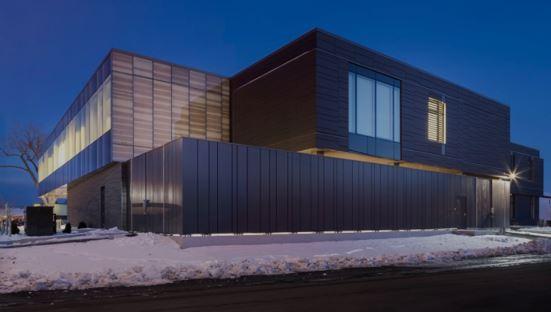As architects, we’re constantly searching for the right textures and patterns for designed surfaces, to complete the site specifics and appearance of our projects, and to harmonize between different elements of the design.
Surface Design in the Digital Age – Expanding Possibilities with Glass
As architects, we’re constantly searching for the right textures and patterns for designed surfaces, to complete the site specifics and appearance of our projects, and to harmonize between different elements of the design. There are always new trends to follow, and cultural and historical elements to consider. While some surfaces in a project may be made of natural materials, such as stone, wood or metal, others may be made with manufactured materials. Often budgetary or functional requirements dictate the use of manufactured surfaces, even if the appearance of a natural material is preferred.
Glass is one of the most popular functional and sustainable manufactured materials employed for architectural surfaces, and for good reason. With its ubiquitous availability, relatively low cost, and energy-efficiency advantages, it is well-suited to a wide range of exterior and interior surface applications. Add to that, the design versatility of being able to print on glass, and it’s clear why almost every project incorporates printed glass surfaces in some way -- whether in retail projects, housing, public buildings, office buildings, urban design, or others.
Glass can be used to create new and unique surface designs for exteriors and interiors that are beautiful and functional. Used in facades, balustrades, balconies, wall covers, floors with ceramic tiles, kitchen backsplashes, doors, and even furniture, glass can mimic the surface design of natural materials, such as wood or marble; or it can take on an entirely creative and unique appearance especially designed for the project.
Technologies for surface design on glass
There are three main technologies for glass printing available for surface design on glass. The existing technologies are differentiated by inks, printers, and software; and each offers varying degrees of durability and versatility.
Screen printing offers high durability, suitable for external and internal surfaces. Inks are transferred onto a substrate through mesh, with certain areas blocked from the ink with stencils, to create the design. It is limited to designs combining a maximum of four colors. Because there are high fixed costs and a very long setup time, screen printing is suitable only for very large quantities of glass panels, all with the same design.
UV digital printing uses organic inks that are fixed and dried to the glass by UV lamps. As a digital technology, this method offers the possibility to combine unlimited colors in the same design. With no fixed costs or setup time it is useful for small quantities and customized orders where each panel is different. However, due to limitations on durability and scratch resistance and a lack of functional inks, surface design applications are limited.
Digital printing with ceramic inks is the most innovative and versatile technology for surface design on glass. On the one hand, digital ceramic printing enables the use of an unlimited color palette, to create almost any image. The inks themselves are extremely durable, as much as those used in screen printing, which uses paste pigments. Think of the durability of stained glass, which can resist hundreds of years with no depigmentation, even when exposed to the elements and extreme weather.
Combine this with the ability to mimic the appearance of any surface material such as wood, marble, or steel, and the ability to print any pattern such as complex arabesques or gradients, or any photorealistic image, and the surface design possibilities become truly endless. This capability totally changes the way we look at glass for architecture. It’s true that as architects many of us are hesitant about using new technologies, perhaps because we’re afraid that over time, building trends will change and materials will lose their edge. Or, perhaps we’re not confident that the printed materials will withstand changing climate conditions, jeopardizing the integrity of both the architect and the building itself.
Fortunately, there are bold architects who have been willing to challenge architectural concepts, and who have been credited with incorporating new materials and technologies that have proven themselves over time.
Designs of any scale, with digital ceramic printing on glass
Until recently, we mostly had to choose surface materials by seeing just a small sample of the surface design and on the basis of that, integrating the material and design across the whole surface. However, with digital ceramic printing on glass it is totally different. Instead of choosing only by sample, we now can create a flexible design with an unlimited amount of variation. The ability to print anything we can imagine on a glass surface frees us from the limitations of design decisions based only on small-scale samples.
The flexibility of digital printing on glass enables us to design a full picture of any kind, in all its details. No matter how many glass panes are being used for a façade, you can design the entire façade as one surface.
An extra benefit of using digital ceramic printing on exterior glass surfaces is that there are software tools available to help with calculating the energy saving performance of the glass. For example, the Dip-Energy web-based tool calculates the transmitted light and the SHGC value of glass printed with a digital image, based on an uploaded digital file of the intended image. With the ability to preview the key energy performance values before even having the glass printed, architects can play with aspects of the design, adjusting it to achieve higher ratings for LEED, BREEAM, and other sustainability accreditations.
Real-world surface design successes with glass
Let’s take a look at two very different case studies of digital ceramic printing on glass, to see how the technology can be used in different sites, with different concepts and techniques. These projects can give you an idea of how you can develop your own surface design as an integral and meaningful ingredient in the recipe for designing an architectural project.
The Montmagny Courthouse, a historical building from 1865, is a renovation project in Canada that features a façade of printed wooden glass panels. The project was designed by a consortium of CCM2, Group A and Roy-Jacques architects, and printed by Laurier Glass.
The architects took high-definition photographs of the wooden panels used for the interiors, and used them to create six different designs. The images were printed on 170 panels of 6 mm glass and installed in alternating order to avoid repetition on the same facade. The integration of digital ceramic printing boosted the high ecological criteria of this building, helping it to gain LEED gold certification.
As a completely different project and way of using glass, consider the Cardboard Cathedral in Christchurch, New Zealand. The building was constructed as a temporary replacement for the historic and iconic cathedral that was destroyed in an earthquake. It features a 12 meter-high, digitally printed glass façade designed by architect Shigeru Ban. Metro Performance Glass used photographs of the original stained glass rose window, lifting the images and printing them directly onto 49 triangular 1.2 meter- tall panels of glass. The ability to easily adjust the transparency levels gives the glass a stained glass appearance. The new window pays homage to the past through the use of modern digital ceramic glass printing technology.
Unmatched surface design possibilities
Those two examples and dozens of other projects incorporating highly imaginative and yet also highly functional surface design would simply not be possible using other glass printing technologies. The creative and innovative possibilities of digital ceramic glass printing for the exterior surfaces of your projects can open up a new world of surface design options for architectural expression.

